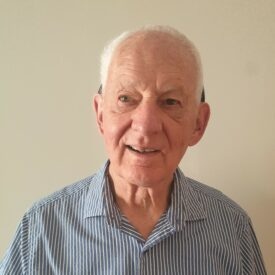
Teleaudiology: a consumer’s perspective
A consumer representative who contributed to the recently published Teleaudiology Guidelines shares his thoughts on the most important aspects of the guidelines and what he envisions for the future of teleaudiology.

Ian Rimes
Contributor to the recently published Australian Teleaudiology Guidelines
Ian volunteers with Better Hearing Australia, a self-help organization for the hard of hearing and holds the position of treasurer on the management committee. Prior to retiring, he worked in the electrical generating industry.
Contact the IntervieweeIan Rimes is passionate about many things. Luckily for us, his passion for helping, and his own experience with hearing issues, had him lend his voice on behalf of others to the recently published the Australian Teleaudiology Guidelines.
Audiologist Lisa Dyre, AuD, recently interviewed Ian and asked him to share a bit about his experience with the Guidelines creation.
Ian, you are a busy man! Tell us a bit about yourself and your interests.
I am a retiree (from the electrical generating industry), now in my 70’s and live on the Central Coast of NSW Australia. I enjoy sailing my catamaran on the nearby waterways, researching family history, and restoring artillery pieces for the Army Reserve museum.
Because of my hearing loss I also volunteer with Better Hearing Australia, a self-help organization for the hard of hearing and hold the position of treasurer on the management committee.
How is your hearing? What has been your experience in receiving hearing health care over the years?
I have had problems with my ears most of my life due to Eustachian tube issues and very bad middle-ear infections, as well as cholesteatomas in both ears. I have had surgeries as well as medical treatment for years and in my 40’s began wearing hearing devices. Due to non-stop middle ear infections, I am now using bone conduction hearing devices.
You are one of the authors of the Australian Teleaudiology Guidelines, can you tell us about your involvement with this?
Sure, I was invited to join the Teleaudiology Working Group as a consumer bringing my lived experience to the table. At first, I felt like a fish out of water as I was the only non-academic but soon found that my concerns were listened to and addressed by the group.
I also sat in on the consumer focus groups and relayed consumer concerns back to the working group. Information was included on the Teleaudiology website in the form of a description, Q&A, and 4 short videos to assist consumers intending to use teleaudiology.
What are the most important aspects of the Guidelines for you personally as a consumer?
Person-centered care and communication.
I was concerned that clients would not receive person-centered care but as the project evolved it became clear the principles for person-centered care of the IDA Institute were built into the Guidelines. Also, it was apparent that with the use of the internet, services can be provided no matter the location; meaning if a client moves their home, or while on holidays, they can still use the services of their ‘tried and trusted’ hearing service provider.
Also, all hearing providers, family, and friends, with the permission of the client can all easily attend the same appointment so that everyone has understanding of the client’s treatment.
Another concern for me was how the audiologist would communicate with their clients. Phone conversations often require more listening effort. This may not be apparent to the audiologist as the patient can sound as if they are having no problems keeping up with the conversation. This has been my biggest problem with hearing loss, and it was important to me to advocate for captioning that is easy to read.
From my own experience and the feedback that I received from other consumers, I suggested that the method of communication should be the client’s choice and where possible the client should have a caregiver, relative or friend sit in on the appointment to pick up what the client may miss.
Now that we have published guidelines, what is your vision for future of remote hearing health care?
The advantages of teleaudiology over in-person appointments are many, so over time I see teleaudiology being the preferred option of consumers to receive their hearing health services. In fact, two of my friends have bought themselves a new phone along with new hearing devices to allow for remote adjustments.
Do you have any advice from a consumer perspective for a hearing care professional offering remote care?
Teleaudiology can be a daunting experience especially for elderly clients or those with little computer skills. Initially, it may mean that audiologists or clinic support staff will need to personally explain to clients how a remote appointment would be conducted and to have a trial appointment with them to build up their confidence. Remember, it is the client’s option to choose the service delivery of their choice.
Ian, thank you for sharing your expertise and experience. Your input for clear communication and patient-centered care underscores its importance for all models of hearing health care service delivery.
As you say, there are consumer advantages for remote hearing health care and more clients like your friends, are likely to choose this option.
For those clinics not offering remote support, or who are looking for more resources for remote support care, download the Phonak Remote Support Quick Start package at eAudiology: Digital Tools for Hearing Care | Phonak.
For information to share with your clients to prepare them for a Teleaudiology appointment, check out the consumer area that Ian mentions on the Teleaudiology Guidelines website: https://teleaudiologyguidelines.org.au/consumer-overview/
